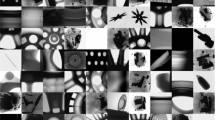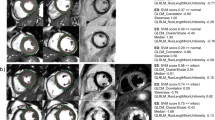Abstract
Objective
The goal of this work is to extract the parameters determining vertebral motion and its variation during flexion–extension movements using a computer vision tool for estimating and analyzing vertebral mobility.
Materials and Methods
To compute vertebral body motion parameters we propose a comparative study between two segmentation methods proposed and applied to lateral X-ray images of the cervical spine. The two vertebra contour detection methods include (1) a discrete dynamic contour model (DDCM) and (2) a template matching process associated with a polar signature system. These two methods not only enable vertebra segmentation but also extract parameters that can be used to evaluate vertebral mobility. Lateral cervical spine views including 100 views in flexion, extension and neutral orientations were available for evaluation. Vertebral body motion was evaluated by human observers and using automatic methods.
Results
The results provided by the automated approaches were consistent with manual measures obtained by 15 human observers.
Conclusion
The automated techniques provide acceptable results for the assessment of vertebral body mobility in flexion and extension on lateral views of the cervical spine.
Similar content being viewed by others
References
Benjelloun M, Mahmoudi S (2007) Spine localization and vertebral mobility analysis using faces contours detection. 29th IEEE annual international conference on engineering in Medicine and Biology society, EMBS07, 23–26 August, 2007, pp 6557–6560, Cité Internationale, Lyon
Benjelloun M, Téllez H, Mahmoudi S (2006) Template matching method for vertebra region selection. 2nd IEEE international conference on information and communication technologies: from theory to applications. (ICTTA’06), Damascus, April 2006, pp 393–398
Blane MM, Lei Z, Civi H, Cooper DB (2000) The 3L algorithm for fitting implicit polynomial curves and surfaces to data. IEE Transactions on Pattern Analysis and Machine Intelligence 22(3): 298–313
Brejl M, Sonka M (2000) Object localization and border detection criteria design in edge-based image segmentation: automated learning from examples. IEEE Trans Med Imaging 19(10): 973–985
Canny J (1986) A computational approach to edge detection, 1986. IEEE Trans Pattern Anal Machine Intell 8: 6
Cootes T, Edwards G, Taylor C (2001) Active appearance models. IEEE TPAMI 23(6): 681–684
Cootes T, Taylor C (1999) Statistical models of appearance for computer vision. Internal report
Cootes TF, Hill A, Taylor CJ, Haslam J (1994) The use of active shape models for locating structures in medical images. Image Vision Comput 12: 355–366
de Bruijne M, van Ginneken B, Viergever M, Niessen W (2003) Adapting active shape models for 3d segmentation of tubular structures in medical images. In IPMI, vol 2732 of LNCS, pp 136–147. Springer, Heidelberg, 2003
Deriche R, Faugeras O (1998) 2d curve matching using high curvature points: application to stereo vision. Proc. International Conf on Pattern Recognition, vol 1, pp 240–242
Pham DL, Xu C, Prince JL (2000) Current methods in medical image segmentation. Annu Rev Biomed Eng 2: 315–337
Howe B, Gururajan A, Sari-Sarraf H, Long R (2004) Hierarchical segmentation of cervical and lumbar vertebrae using a customized generalized hough transform. Proc IEEE 6th SSIAI, pp 182–186, Lake Tahoe
Kass M, Witkin A, Terzopoulos D (1987) Snakes: active contour models. Int J Computer Vision 1: 321–331
Kauffman C, Guise JA (1997) Digital radiography segmentation of scoliotic vertebral body using deformable models. SPIE Med Imaging 3034: 243–251
Keren D (2004) Topologically faithful fitting of simple closed curves. IEEE Trans PAMI 26(1)
Keren D, Gotsman C (1999) Fitting curves and surfaces with constrained implicit polynomials. IEEE Trans PAMI 21(1)
Lie WN, Chen YC (1986) Shape representation and matching using polar signature. Proc Intl Comput Symp, pp 710–718
Lobregt S, Viergever MA (1995) A discrete dynamic contour model, 1995. IEEE Trans Med Imaging 14(1)
Long LR, Thoma GR (1999) Segmentation and feature extraction of cervical spine X-ray images, Proc SPIE medical imaging image processing, vol 3661, San Diego 20–26 February, pp 1037–1046
Long LR, Thoma GR (2000) Use of shape models to search digitized spine X-rays. Proc. IEEE computer-based medical systems, pp 255–260, Houston
Long LR, Thoma GR (2001) Identification and classification of spine vertebrae by automated methods. Proc SPIE medical imaging 2001: image processing, vol 4322
Rico G, Benjelloun M, Libert G (2001) Detection, localization and representation of cervical vertebrae. Computer vision winter workshop, Bled, pp 114–124
Stanley RJ, Long LR, Antani S, Thoma GR, Downey E (2004) Image analysis techniques for the automated evaluation of subaxial subluxation in cervical spine X-ray images. Proceeding of the 17th IEEE symposium on computer-based medical systems CMBS04
Sethian JA (1996) Level set methods. Cambridge University Press, Cambridge
Smyth P, Taylor C, Adams J (1999) Vertebral shape: automatic measurement with active shape models. Radiology 211(2): 571–578
Tezmol A, Sari-Sarraf H, Mitra S, Long R, Gururajan A (2002) A customized hough transform for robust segmentation of cervical vertebrae from X-ray images. Proc. 5th IEEE southwest symposium on image analysis and interpretation, Santa Fe
Verdonck B, Nijlunsing R, Gerritsenand FA, Cheung J, Wever DJ, Veldhuizen A, Devillers S, Makram-Ebeid S (1998) Computer assisted quantitative analysis of deformities of the human spine. Proceeding of international conference of computing and computer assisted interventions, LNCS, pp 822–831. Springer, Heidelberg
Vosselman G, Haralick R (1996) Performance analysis of line and circle fitting in digital images. Proceedings of the workshop on performance characteristics of vision algorithms, Cambridge
Zamora G, Sari-Sarrafa H, Long R (2003) Hierarchical segmentation of vertebrae from X-ray images. Med imaging: image process, vol 5032 of Proc of SPIE, pp 631–642. SPIE Press
Zheng Y, Nixon MS, Allen R (2004) Automate segmentation of lumbar vertebrae in digital videofluoroscopic images, 2004. IEEE Trans Medical Imaging 23(1): 45–52
Author information
Authors and Affiliations
Corresponding author
Electronic supplementary material
This file is unfortunately not in the Publisher's archive anymore: (CLS 41 kb)
Rights and permissions
About this article
Cite this article
Benjelloun, M., Mahmoudi, S. X-ray image segmentation for vertebral mobility analysis. Int J CARS 2, 371–383 (2008). https://doi.org/10.1007/s11548-008-0149-1
Received:
Accepted:
Published:
Issue Date:
DOI: https://doi.org/10.1007/s11548-008-0149-1




